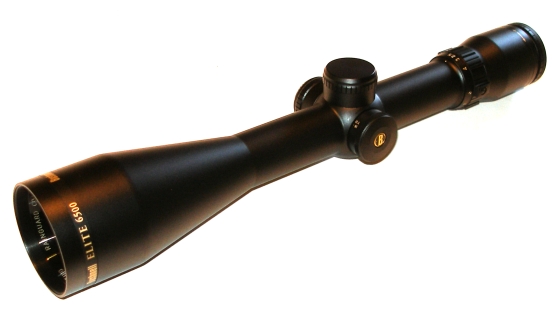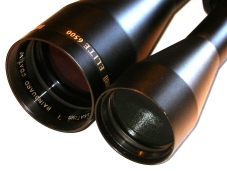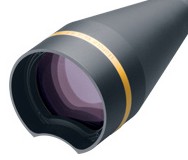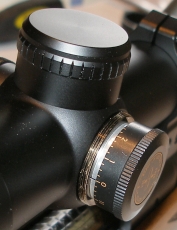It seems like everyone I served with in the military was a Southerner. They taught me most of what I know about hunting and fishing and, in exchange, I’d like to think I taught them something about the game of poker. Broke most of the time and struggling to support young families, hunting was sometimes more of a necessity than a sport. I think everyone in our group carried a sporterized Mauser, built with parts from the old Herter’s catalogue and topped with a Bushnell 4x-32mm scope. The combination was inexpensive, accurate and reliable even in the face of some fierce South Dakota winters. Eventually we came home to chase the ever elusive American dream and Bushnell just kept right on making excellent scopes.

When Real Guns recently put together a project for a high power centerfire rifle with long range potential, we found the application opened the door to some new opportunities for scope selection. So we laid out the project goals, set aside habitual buying practices, worked through specification details and product assessment and concluded with a Bushnell Elite 6500. Our choice was a model 65-2165MD, a slick looking matte black, side focus, 2.5 -16 x 50mm with a Mil-Dot reticle. Since I am in procrastination mode, with a pile of handloading components in front of me and a lot of manual labor ahead, I thought I would look as busy as possible and share some scope info.
Is that a small deer or is it just far away….
 I’ve always liked the idea of a high power scope on a rifle that has obvious long range potential. Unfortunately, almost all high magnification scopes have limited low magnification capability; defined as low light transmission, narrow depth of field, too much magnification at the low end – i.e. 6x, even 4x, is too much glass for a running fifty yard shot…regardless if it is me or the game doing the running.
I’ve always liked the idea of a high power scope on a rifle that has obvious long range potential. Unfortunately, almost all high magnification scopes have limited low magnification capability; defined as low light transmission, narrow depth of field, too much magnification at the low end – i.e. 6x, even 4x, is too much glass for a running fifty yard shot…regardless if it is me or the game doing the running.
The Elite 6500 pretty much offers the best of both worlds. Its 2.5 – 16x magnification range is wider than any other scope on the market, regardless price. At the top end of the magnification range there is plenty of power for extended shooting ranges and at the low end there is a huge bright 42′ field of view. My point is, and yes I do have a point, neither high end or low end magnification is a compromise with the Elite 6500.
Power to the Pupil… Sorry, I couldn’t help myself
 A rifle scope’s light gathering capability and efficiency of light transmission have to compliment magnification to produce the best image. The Bushnell Elite 6500 2.5 -16 x 50mm produces bright, sharp images at all magnification levels; the result of a combination of: a large objective lens, multiple lens coatings to reduce glare and efficiently transmit light, a light baffled interior to minimize flare and loss of contrast from reflective surfaces, a big 30mm tube, and a nifty 36mm ocular lens inside of a 42mm eyepiece.
A rifle scope’s light gathering capability and efficiency of light transmission have to compliment magnification to produce the best image. The Bushnell Elite 6500 2.5 -16 x 50mm produces bright, sharp images at all magnification levels; the result of a combination of: a large objective lens, multiple lens coatings to reduce glare and efficiently transmit light, a light baffled interior to minimize flare and loss of contrast from reflective surfaces, a big 30mm tube, and a nifty 36mm ocular lens inside of a 42mm eyepiece.
A 50mm objective really is a requirement for any scope above 9x in magnification that has to work across a hunter’s range of ambient light conditions. A large objective lens enhances low ambient light dusk and dawn performance and provides more light at high magnification levels where a scope’s exit pupil is minimal. A 10mm increase in a scope’s objective lens, from 40mm – 50mm (Pictured left-right), equates to a 56% increase in objective lens surface area and potentially 56% increase in light coming into the scope. An increase in objective lens diameter directly interprets into a greater area of eyepiece illumination.
The column of light passing through the eyepiece is called the exit pupil. The diameter of the column determines how much of the shooter’s eye pupil is illuminated when looking through the eyepiece. In normal room light a person’s pupil is approximately 3 – 4mm in diameter. Typical daylight causes the iris to constrict, reducing the opening to the pupil to approximately 1.5mm. The Elite 6500 produces a 20mm scope exit pupil at 2.5x magnification, a 5mm exit pupil at 10x and a 3.1mm exit pupil even at 16x. In short, there is more than enough light covering the shooter’s pupil across the magnification range. The formula for exit pupil diameter is the clear objective lens diameter divided by the level of magnification, which of course means the exit pupil reduces in size as magnification increases and large objective scopes will always have a larger exit pupil diameter than their smaller objective brothers at any given common magnification.
How low can you go?

In our search to shorten everything about firearms, we sometimes get some unexpected results. The other day, I tried to mount a Burris Compact scope on a Ultra Light Ruger chambered for the .257 Roberts and found the scope tube was too short to span the action, so much so that offset mounts would not make up the difference. Some of the very short high power scopes pull their objective bells so close to a rifle’s receiver, and back from the barrel’s taper, they often require a high or extra high mount for objective bell clearance. The 13½” Bushnell Elite 6500 puts the objective bell out where it belongs and subsequently requires only a medium height mount for clearance. In this case, I used a set of tough Warne steel bases and rings purchased from Brownells. Even the Leupold VX-7, with its duckbill objective lens, mounts no closer to a rifle bore’s centerline.
 Low mounting a scope, within reason, is important. The resulting geometry minimizes the angle of incidence between optical line of sight and bore centerline to assure minor scope adjustment and trajectory compensation will not have an exaggerated result. Years ago, scope height was usually set at the point where the scope’s objective bell just barely cleared a rifle’s barrel. These days, mount height has to accommodate adequate clearance between large 42mm eyepieces and cycling bolt handles.
Low mounting a scope, within reason, is important. The resulting geometry minimizes the angle of incidence between optical line of sight and bore centerline to assure minor scope adjustment and trajectory compensation will not have an exaggerated result. Years ago, scope height was usually set at the point where the scope’s objective bell just barely cleared a rifle’s barrel. These days, mount height has to accommodate adequate clearance between large 42mm eyepieces and cycling bolt handles.
Working down toward the goal of having the lowest mount height for greater shooting comfort can be counter productive and may apply only to stock geometry where there is an extreme amount of drop at the stock’s comb. Perhaps rifles originally intended for use primarily with metallic sights would be the best candidates for very low scope mounting. A modern Remington Model 700 CDL, as an example, has only a 1 ⅛” drop at the comb and is intended for use with a scope and medium height mounts are necessary to allow a shooter’s eye to line naturally with a scope’s eyepiece. Some stock drop is more the product of an optical illusion. The comb of a hog’s back stocked CZ European style stock is actually ⅛” higher than the Remington stock I just used in example, even though the heel of the stock is inches lower. Low mounts would leave most shooters looking over the top of an eyepiece with a rifle held in a natural hold and with comfortable stock-face contact.
Beware of high flying ducks…
 Leupold’s VX-L crescent shaped objective lens, designed specifically for low scope mounting, is technically interesting. However, the size of it’s objective is smaller than a true 50mm scope and it still has to be mounted high enough for a bolt handle to clear the scope’s large eyepiece as noted previously. That’s why this product is often seen mounted with its duckbill floating a half inch or more above a barrel. The crescent lens approach may have other penalties. Besides broadcasting a shooter’s desperate cry for attention, as Leupold suggests “The 50mm VX-L® mounts as low as a 36mm riflescope, yet delivers 48.6 percent more Total Light Throughput™ (TLT)”. A true 50mm lens has 93% more surface area than a 36mm objective, yet the VX-L manages to produce less than 50% more light. The product is listed as having a clear objective of 48mm, however, a run through with a calculator suggests the lens passes light more in line with a 44mm objective lens. Not a lot of scope for $800, but then it does come with a box full of acronyms.
Leupold’s VX-L crescent shaped objective lens, designed specifically for low scope mounting, is technically interesting. However, the size of it’s objective is smaller than a true 50mm scope and it still has to be mounted high enough for a bolt handle to clear the scope’s large eyepiece as noted previously. That’s why this product is often seen mounted with its duckbill floating a half inch or more above a barrel. The crescent lens approach may have other penalties. Besides broadcasting a shooter’s desperate cry for attention, as Leupold suggests “The 50mm VX-L® mounts as low as a 36mm riflescope, yet delivers 48.6 percent more Total Light Throughput™ (TLT)”. A true 50mm lens has 93% more surface area than a 36mm objective, yet the VX-L manages to produce less than 50% more light. The product is listed as having a clear objective of 48mm, however, a run through with a calculator suggests the lens passes light more in line with a 44mm objective lens. Not a lot of scope for $800, but then it does come with a box full of acronyms.
The VX-L’s 1″ tube is more restrictive than the Bushnell scope. The Bushnell tube at 30mm is approximately 0.180″ larger. This makes for a structurally stronger scope and allows more room for a robust erector lens mounting system that won’t obstruct the interior of the tube and diminish light throughout. The Elite 6500’s increased tube diameter also allows for a full 80″ range of elevation and windage adjustment. Neat. To be fair, I selected a more traditional, but higher performing Leupold scope for use in the comparison matrix that follows.
Software not required…
 The Elite 6500 has simple to operate, cleanly indexed controls that click off in precise ¼ MOA. increments and result in very predictable changes to point of impact on a target. Additionally, the adjustment knobs can be pulled up to disengage from active adjustment and reset to zero, as pictured left, to facilitate easy field adjustment. I noticed, even under jaw bone jarring recoil, the scope adjustments stay put, which is always a good thing.
The Elite 6500 has simple to operate, cleanly indexed controls that click off in precise ¼ MOA. increments and result in very predictable changes to point of impact on a target. Additionally, the adjustment knobs can be pulled up to disengage from active adjustment and reset to zero, as pictured left, to facilitate easy field adjustment. I noticed, even under jaw bone jarring recoil, the scope adjustments stay put, which is always a good thing.
The Bushnell scope has side focus adjustment for parallax; a nice touch that permits correction without the shooter moving out of position. What is parallax? It is an image focused on a plane ahead of, or behind, a scope’s reticle. If a shooter moves his eye sway from optical center, a result would be an apparently shift in image or reticle. If he stays lined up with the optical center the issue of parallax will be moot. Adjusting out parallax will do the same.
 Parallax adjustment usually comes in one of three forms. Preset, when a manufacturer picks a compromise range indicative of how the scope was intended to be used, and sets the corrected range at the factory. A typical centerfire rifle is set at perhaps 150 yards, a slug gun perhaps at 50 yards. The second method is an adjustable objective where the front lens is turned to move it closer to, or farther from, the erector cell to bring the image to the same plane as the scope’s reticle at the desired shooting distance. The third method keeps the objective lens stationary and racks elements of the erector cell fore and aft to place the image on the same plane as the reticle. Bushnell uses the last method with a feature called side focus. The benefit of this approach is that the shooter can adjust out parallax without moving out of shooting position.
Parallax adjustment usually comes in one of three forms. Preset, when a manufacturer picks a compromise range indicative of how the scope was intended to be used, and sets the corrected range at the factory. A typical centerfire rifle is set at perhaps 150 yards, a slug gun perhaps at 50 yards. The second method is an adjustable objective where the front lens is turned to move it closer to, or farther from, the erector cell to bring the image to the same plane as the scope’s reticle at the desired shooting distance. The third method keeps the objective lens stationary and racks elements of the erector cell fore and aft to place the image on the same plane as the reticle. Bushnell uses the last method with a feature called side focus. The benefit of this approach is that the shooter can adjust out parallax without moving out of shooting position.
The range markings on any parallax adjustment are more relative than absolute. The easiest way to know if the adjustment is correct for your shooting distance is to move your eye slightly off the center of the eye piece and see if the image or reticle shifts. If it does, make a parallax adjustment until it does not. Easy to do when you’re looking through the eyepiece and still able to turn the parallax adjustment. Not so easy when you have to keep taking the rifle down from your shoulder, make an adjustment at the objective lens; put it back up to your shoulder, take it down from your shoulder, make further adjustment, repeat, repeat, repeat… For a more critical parallax adjustment, it is good to change eyes and, while moving side to side with one eye, keep the other one blinking. If that doesn’t get you there try tapping your toe to the time of the blinking. At the very least, your friends at the range will appreciate the performance.
If you Google “rifle scope+side focus adjustment” you will find two or three hundred ways to sneak up on parallax adjustment while taking into consideration mechanical assembly lash…or slop. The idea is that you end the adjustment without slack in the adjustment. I don’t know if this is for real or just so much overcomplicated crapola, but I will check it out on the live fire portion of the project and let you know what happens, as long as you’re not still busy blinking your eyes and tapping your toes.
Sometimes the best features are the ones that aren’t there
Swarovski’s Ballistic Turret feature requires a twelve step interactive animation just to explain its use. When I was done…interacting, I realized the Ballistic Turret bears an uncanny resemblance to the shooting distance index marks and range estimating function on a $60 Tasco scope I bought in 1972, a feature I never found useful even then. Modern manufacturing has taken the extreme cost out of making precision optics and close tolerance mechanical assemblies. These days, with scopes like the Swarovski bumping against the $2,000 mark, companies are getting a little far fetched in coming up with features in an attempt to justify product prices.
 While there are several reticle options for the Elite 6500, the 65-2165MD version of the Elite 6500 I selected has a Mil Dot reticle. If you’re not familiar with this type of reticle, beginning at the center of the reticle as a reference point, and ending at the tip of the thicker reticle line, there are five equal spaces between dots for a total of ten spaces vertically and ten horizontally. At reference magnification, 10x in the case of the Elite 6500, each space is exactly one mil. Because at reference magnification the reticle size is fixed, but apparent target size changes with distance, a mil’s relative size varies with distance. At one hundred yards the space between mil dots is 3.6″, at 500 yards it is 18″ or exactly 5 times the size and at 1000 yards it is 36″. Used as intended, a Mil Dot reticle can provide distance, hold over, lead, and game size information without the shooter moving his eye off the eyepiece. There are no complex mechanical devices to operate, or batteries to fail and no distractions to shooting. The first time I used one of these I spent a day or two of “Huh?” time, but then its use became second nature. It took a little longer for me to get comfortable with the affect magnification change has on Mil Dot size reference, but even that came with routine shooting practice. I’m glad I made the time investment as it paid off with improved shooting performance. For more information on all things Mil Dot and a lucid version of what I just attempted before running out of steam and space… If all else fails, the Mil Dot works just as well as a conventional cross hair.
While there are several reticle options for the Elite 6500, the 65-2165MD version of the Elite 6500 I selected has a Mil Dot reticle. If you’re not familiar with this type of reticle, beginning at the center of the reticle as a reference point, and ending at the tip of the thicker reticle line, there are five equal spaces between dots for a total of ten spaces vertically and ten horizontally. At reference magnification, 10x in the case of the Elite 6500, each space is exactly one mil. Because at reference magnification the reticle size is fixed, but apparent target size changes with distance, a mil’s relative size varies with distance. At one hundred yards the space between mil dots is 3.6″, at 500 yards it is 18″ or exactly 5 times the size and at 1000 yards it is 36″. Used as intended, a Mil Dot reticle can provide distance, hold over, lead, and game size information without the shooter moving his eye off the eyepiece. There are no complex mechanical devices to operate, or batteries to fail and no distractions to shooting. The first time I used one of these I spent a day or two of “Huh?” time, but then its use became second nature. It took a little longer for me to get comfortable with the affect magnification change has on Mil Dot size reference, but even that came with routine shooting practice. I’m glad I made the time investment as it paid off with improved shooting performance. For more information on all things Mil Dot and a lucid version of what I just attempted before running out of steam and space… If all else fails, the Mil Dot works just as well as a conventional cross hair.
Comparisons with similarly priced product…
It’s difficult to select product for a comparison matrix, as there is so little relationship between price and features in better scopes these days. I didn’t list very expensive scopes, above $1,500, mostly because they added little in the way of performance or because they had very unique features that fit only very specialized applications. I felt those I selected for the table below to be reasonable alternatives within a price – performance range. They all comfortably wear the premium scope label.
| Attribute | Bushnell Elite 6500 |
Burris Black Diamond |
Leupold VX-III |
Zeiss MC Conquest |
| Typical Retail Price | $699 | $725 | $699 | $874 |
| Magnification range | 2.5 -16 x 50mm | 4-16x 50mm | 4.5-14x 50mm | 4.5-14x 50mm |
| Objective Bell | 58mm | 58mm | 58mm | 56mm |
| Objective Lens | 50mm | 50mm | 51mm | 50mm |
| Side Focus | Y | Y | Y | Y |
| Tube Diameter | 30mm | 30mm | 30mm | 1″ |
| Click Adjustment Increments | ¼ MOA | ¼ MOA | ¼ MOA | ¼ MOA |
| Weight oz. | 21 | 21.9 | 17.0 | 19.7 |
| Length | 13.5″ | 15.7 | 12.8 | 14.0 |
| Field of View + – Magnification | 42′ – 7′ | 27′ – 7.5′ | 19.1′ – 7.4′ | 25.5′ – 8.8′ |
| Minimum Eye Relief | 3.9″ | 3.3″ | 4.4″ | 3.5″ |
| Eyepiece Diameter | 42mm | 42mm | 41mm | 41mm |
| Exit pupil | 20 – 3.2 mm | 12 – 3.1 | 11.1 – 3.6 mm | 10.8 – 3.6mm |
| Range of Adjustment | 80″ | 74″ | 100″ | 45″W/68″E |
I am typically the guy who says, “I can get that performance out of a $79 scope” and I often can. Not this time. The improvements over a bargain scope are noticeable and measureable and, in fact, the Elite 6500 is an improvement over most premium priced scopes. It is not an insignificant expenditure, but then it returns enough on the investment to make it an excellent value. I can’t ask for much more than that. I will cover the scope’s field performance within the larger long range shooter project.

Email Notification